|
Getting your Trinity Audio player ready...
|
OWN VOICE. ~ InPerspective by Bruce Laird and Gregg Dieguez —
This article provides a method you can use to assess and manage your COVID-19 risk for the holidays. You can tailor the analysis to your situation, or cast caution to the winds and ignore it altogether. We offer it as our holiday gift to all because we know people want to celebrate the holidays together, and here’s a way to do so relatively COVID-safely.
Footnotes: to use, click the bracketed number and then click your browser Back button to return to the text where you were reading.
Images: We’ve kept them mostly small to avoid distracting the reader. Click on them to enlarge for improved readability in a new window.
Face it, I wanted to celebrate Thanksgiving, you want your Hanukkah or Christmas, and we’re not gathering with friends and old relatives over dinner or drinks wearing masks and without hugging. We’re social animals and that’s why our species has survived (so far). So what should we do to both enjoy each other and be safe? This article describes one way you can celebrate together in these COVID times, and gives you the tools to adjust the risk analysis to suit your community and personal realities. While it’s based on studies, data, and articles by leading virologists and epidemiologists, the suggestions are ours – so feel free to consult with medical professionals of your choice, or your Aunt who has a neighbor who knows a guy who took Ivermectin and hasn’t caught COVID yet.
Let’s start with some context on where we are with COVID. If you want, jump ahead to Planning A COVID Christmas Gathering.
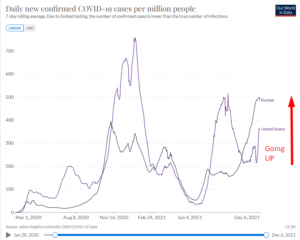
The Current COVID Reality:
We were going to have a holiday surge of COVID anyway, but the news about Omicron just makes it more obvious. The trend of cases has been going up for weeks, led by Europe and, as always, followed closely by the U.S. When we started writing this article last week, the first U.S. case of Omicron had just been discovered in San Francisco. As of 12/8/21, over 15 19 states now have cases. And of course the prevalence of COVID will depend on your behavior and state and local leadership (or lack thereof). Our increased level of holiday travel is going to spread COVID, again – a Dutch study found 10% of the airline passengers from S. Africa had COVID.
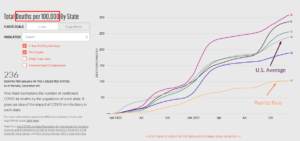
In the past 6 months alone over 150,000 unvaccinated people have died from COVID and unvaccinated people have 14 times higher risk of death than vaccinated.. Unless you live in a region with a clear understanding of promoting the general welfare and personal responsibility, like Puerto Rico, your risk of catching COVID is significantly higher. Because Omicron can evade both vaccines and acquired immunity from prior infection[1], either another vaccine or booster shots (which seem to work with mRNA vaccines)[2] will become part of life, and the disparity in health and death between the vaccinated and unvaccinated will grow. But what is YOUR risk?
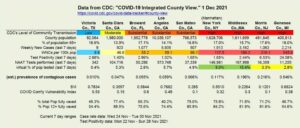 Regardless of the variant of the day, you can track your local County risks of COVID using CDC data from this site. The table at left shows some selected counties and the variances in risks they each face. We consider the best measure of risk the number of Daily New Cases in the past week, per 100 thousand of population. There are other possible measures and considerations, but we discuss why we favor this metric in our Technical Appendices. Taking Genesee County, Michigan as an example, the chance that anyone you encounter has COVID is thus: 2,214 cases in a week divided by 405,813 population, which is 545.6 weekly DNCs per 100,000, or a probability of 0.546%. So what should you do in deciding whether to attend or host a group gathering for the holidays?
Regardless of the variant of the day, you can track your local County risks of COVID using CDC data from this site. The table at left shows some selected counties and the variances in risks they each face. We consider the best measure of risk the number of Daily New Cases in the past week, per 100 thousand of population. There are other possible measures and considerations, but we discuss why we favor this metric in our Technical Appendices. Taking Genesee County, Michigan as an example, the chance that anyone you encounter has COVID is thus: 2,214 cases in a week divided by 405,813 population, which is 545.6 weekly DNCs per 100,000, or a probability of 0.546%. So what should you do in deciding whether to attend or host a group gathering for the holidays?
Planning A COVID Christmas Gathering:
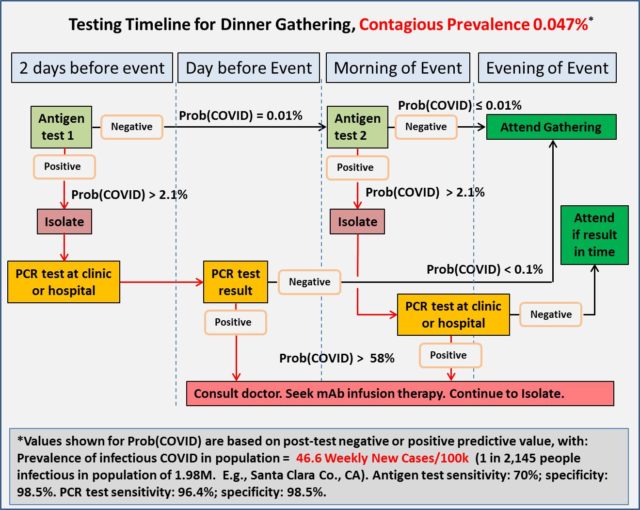
Answer: Test everyone. Twice. And here’s how, as shown in the flowchart at right. There are two major classes of tests, with slight differences in accuracy. This procedure can employ both test types, to minimize the chances of a false test result. For each potential attendee, buy a home antigen test kit (about $25 at your local pharmacy) which has two tests in a package. Two days in advance, each person takes an at-home antigen test and gets the results in about 15 minutes. If they are negative, they test themselves again on the day of the event (well, you could test them at the door and make them wait in the mud room or the garage, but that gets awkward). If they are still negative after both tests, they attend the gathering. If your first test is positive, that should be concerning, and it might be wrong, so you get a more precise PCR test at a clinic or hospital. In the meantime you Isolate yourself so as to avoid infecting others. If the PCR test is negative, you attend the gathering. Other combinations of test outcomes (refer to the flowchart) will cause you to miss the event and maybe ask for a doctor’s prescription for monoclonal antibody treatment, which has a good chance of preventing serious COVID illness if you get the treatment EARLY in the disease course. The probabilities shown on the flowchart were Santa Clara County, CA data as of Dec. 1st. Everything is changing rapidly; San Mateo County has just about doubled in contagious prevalence since then. So, to allow people to estimate their risks in the face of ever-changing disease conditions, we have provided a spreadsheet you can download and update yourself (click here to open). [Visual instructions for downloading are shown in red lines in the image below right.>>]
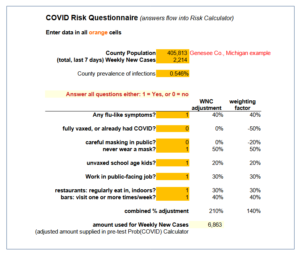
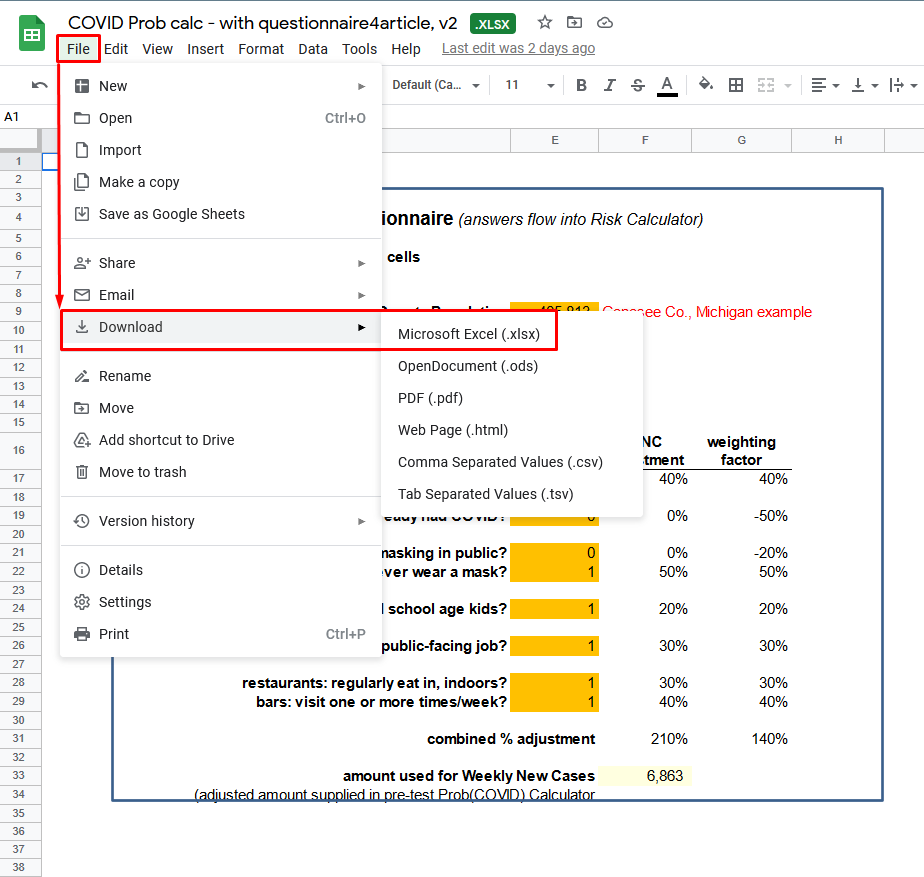
To use it, fill in YOUR county’s information by finding it on the CDC website. Then – because everyone’s behavior and situation is different – tailor your results based on whether you have flu-like symptoms, are vaccinated, have been wearing a mask or not (Not: Will be wearing a mask), have school kids at home, work in a public-facing job, or socialize regularly.
Enter the data in the GOLD cells (< image at left), where 1 means Yes and 0 (zero) means No, and the spreadsheet will adjust the county-wide risk probabilities for your situation.
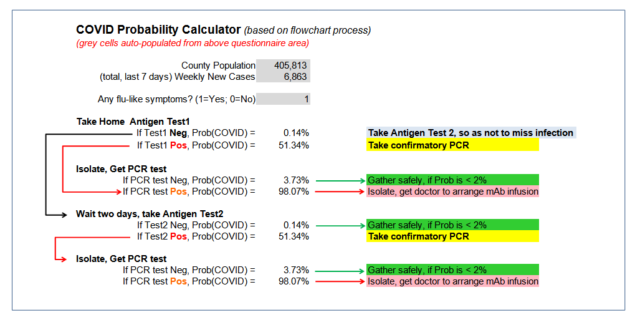
After you’ve done that, scroll down on the spreadsheet and the next section will show your resulting COVID risks with the same logic flow as the flowchart (image at right >). Then as you gather information from your tests, you can see the risk percentages you face. Clearly there are a lot of decisions and assumptions we’re making in this spreadsheet, and we explain them in the Technical Appendices for those curious. The decisions YOU make will determine your risk… First, will you and your guests get tested, as we suggest? Second, what is the “safe” threshold you’ll accept based on the test results? We’ve suggested it’s safe to gather if a person’s COVID probability is under 2%. Your risk tolerance may vary, and if you’re gathering often, consider the implications of compounding the risk.
Compounding The Risk:
The preceding procedure will allow you to estimate the safety for each attendee at your holiday gathering. But now a word about Compound Probability… So, if you conduct a risk assessment for each guest, and there is only a 1% chance that each person has COVID, but you have 10 people… then the combined probability that NONE of them have COVID is only 90.4%. In this example, your chance of exposure to COVID-19 would be about 10%.
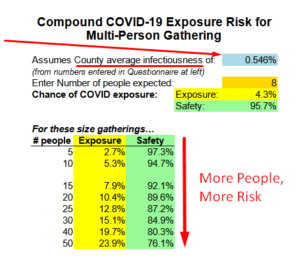
And if you attend a number of such gatherings, say 5 of them over the Holidays, then the probability you will NOT be exposed to COVID falls to 60.5% – put another way, there’s a 40% chance you WILL be exposed to COVID under this repeat Holiday Party scenario. You might not catch it, even if exposed, and if you do catch it you might not get severely ill; those are probabilities that depend on your degree of exposure, your age, vaccination status, and health. It’s a personal decision how many times you want to take how much risk, but repeated risk-taking will decrease your chances of safety.[3]
And what if your guests do NOT follow the double test procedure we described, which can lower your chances of exposure to COVID-19 to very small levels? Suppose everyone just shows up, and you’re taking your chances with the average risk of COVID-19 exposure in your county? We’ve added a section to the spreadsheet (example, above left) which takes the COVID-19 exposure you entered previously for your County and it allows you to specify the number of guests, and/or assess the sensitivity of your exposure for a range of numbers of guests (including you and your family).
Personally, we’ll be having Christmas Eve Dinner with old, vaccinated friends… but outside in the daytime. If you want to really improve your chances of a safe Holiday Season, follow the two-test regimen described above, and celebrate life with people you love (and/or family you tolerate, as the case may be). Enjoy the Holidays Responsibly….
FOOTNOTES:
[1] Omicron coronavirus variant three times more likely to cause reinfection than delta, S. Africa study says
https://www.washingtonpost.com/world/2021/12/03/omicron-covid-variant-delta-reinfection/
“Omicron is probably the fastest-spreading variant that South Africa has ever seen,” said Tulio de Oliveira, a public health professor at South Africa’s Stellenbosch University.
[2] mRNA Boosters may protect from Omicron
Excerpts: “Pfizer, BioNTech vaccine neutralises Omicron with three shots in a laboratory test …. and they could deliver an upgraded vaccine in March 2022 if needed…. The German and U.S. companies said two doses of their vaccine resulted in significantly lower neutralising antibodies but a third dose boosted those antibodies by a factor of 25. The findings are broadly in line with a preliminary study published by researchers at the Africa Health Research Institute in South Africa on Tuesday, which said Omicron could partially evade protection from two doses of the Pfizer/BioNTech vaccine and suggested a third shot might help fend off infection.”
[3] Thinking About Repeated Risk-taking
I quit racquetball for a year because I calculated that even if I was 99% safe playing an indoor sport for several hours at a time, if I played three times a week for a year I was only 22% likely to avoid catching COVID – thus 78% likely to catch it, which was not desirable in 2020 with treatment overwhelmed and doctors still learning what to do. That’s the impact of compound probability. Prior to vaccines and monoclonal antibody injections and all the other improvements in treating COVID that we’ve learned the hard way over the past two years, that was a level of risk I did not want to take. Further, if you live in a region where you might not even be able to get into a hospital because they’re stuffed with COVID patients, you can’t count on those advances helping you or your family member.
Foundations of this approach – Technical Appendices
To fully understand the research, assumptions, and thinking underpinning the approach to estimating risk contained in this article, we’re providing as Technical Appendices two of Bruce’s periodic COVID updates:
COVID Update 140: Rapid antigen testing: Two tests are better than one
COVID Update 139. Home antigen tests: how to use them for safer holiday gatherings; how to interpret antigen test results
 More From Gregg Dieguez ~ “InPerspective”
More From Gregg Dieguez ~ “InPerspective”

Mr. Dieguez >> is a native San Franciscan, longtime San Mateo County resident, and semi-retired entrepreneur who causes occasional controversy on the Coastside. He is a member of the MCC, but his opinions here are his own, and not those of the Council. He lives in Montara. He loves a productive dialog in search of shared understanding. >>
<< Mr. Laird is another semi-successful, semi-retired MIT entrepreneur but with more degrees, living in Los Altos. They roomed and caused trouble together back in the day. Bruce produces a periodic newsletter on the science and implications of COVID-19. For a free subscription, contact Bruce at: laird2007@hotmail.com



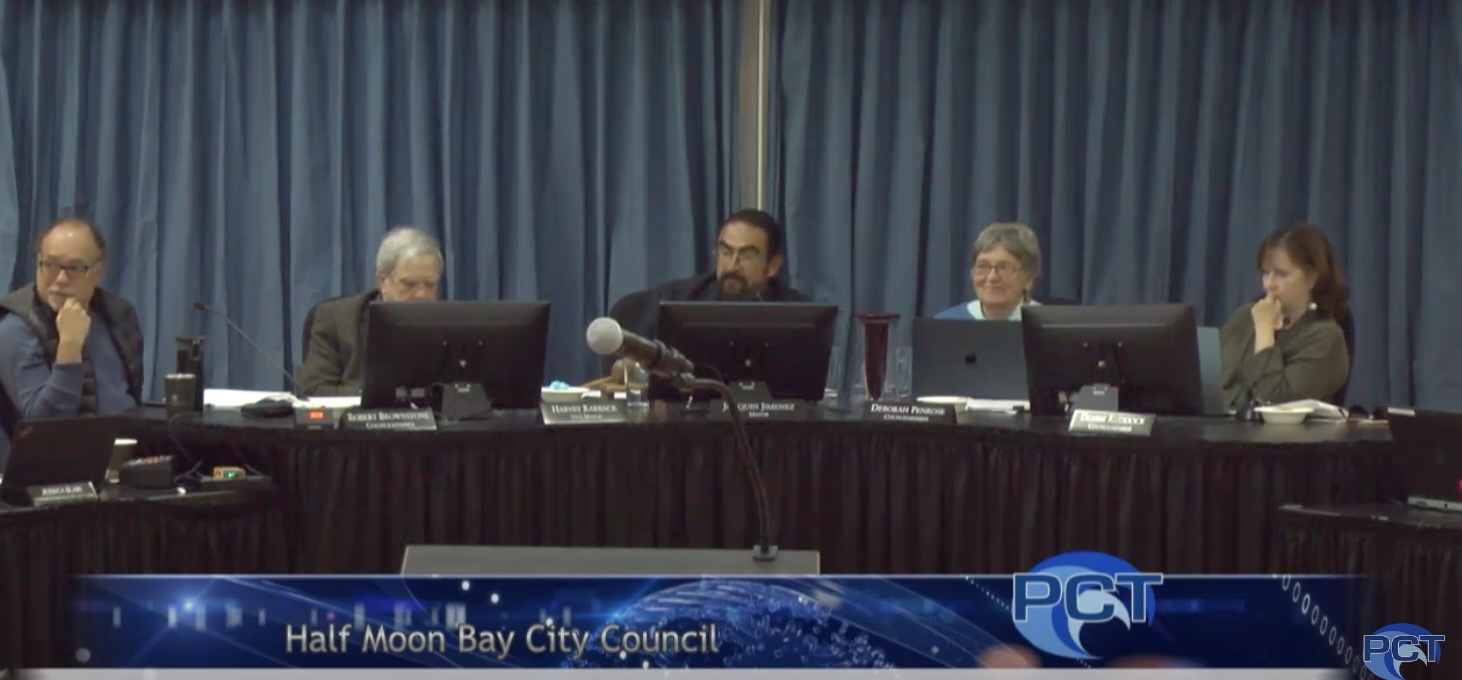

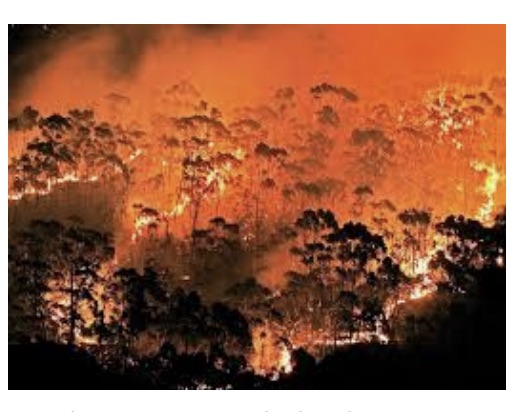
Well, I’d expect nothing less, – the greatest hits- let’s see disparage Ivermectin, & it’s the “unvaccinated” who are being hospitalized, however nothing mentioned about Trump? not even as scrooge? you are missing a step, must be your booster kicking in. How about there is nothing you can do! the vaccine doesn’t work, boosters weaken your immune system, it’s the vaccinated who are catching and spreading, and being hospitalized. Omicron is a snooze but Gregg adds to the fear. The recently FDA released Pfizer trial documents (irrefutable) 3% of the trial participants (over 1000) died in the first two months – why doesnt Gregg speak to the Pfizer document, it’s now available as a judge refused Pfizer’s request to not make it public for 50 years – what is there to hide, will Gregg ever reveal?